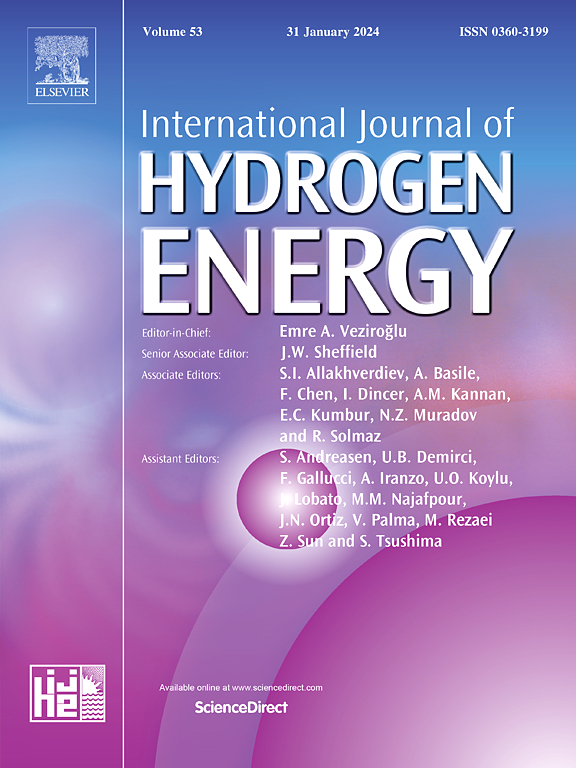Comprehensive review of bipolar plates for proton exchange membrane fuel cells with a focus on materials, processing methods and characteristics
IF 8.3
2区 工程技术
Q1 CHEMISTRY, PHYSICAL
引用次数: 0
Abstract
Proton exchange membrane fuel cell (PEMFC) is being developed as a key component of climate change mitigation and post-pandemic economic recovery strategies, especially for the hard to decarbonized sectors like transport. This requires lightweight and highly performing PEMFCs, and bipolar plates (BPs) usually takes around 80% of the weight and volume of the PEMFCs. Bipolar plate provides conducting path for electrons from cell to cell, structural support to cell stack, uniform reactant flow along with removal of biproducts. Fuel cell efficiency, its power density, energy density with water and heat removal are the function of BPs performance, during operation. Whereas the performance or characteristics of BPs i.e., conductivity, gas permeability, hydrophobicity, mechanical and electrochemical durability depends on its quality, which have direct relationship with the material choice, manufacturing method, their parameters and flow field design. Several reviews extensively presented design aspect of flow fields of BPs, whereas a notable comparative analysis of materials, characteristics along with manufacturing processes need to be addressed to encourage better understanding towards efficient PEMFCs and to reduce weight and volume of fuel cell stack. This review aims to provide a comprehensive insight about recent materials (graphite, metallic, and composite materials), processing methods, and characteristics of developed bipolar plates for PEMFC. It highlighted and proposed the various research directions and provide the guidance for the future development of bipolar plates and to obtain optimum combination of required properties, simultaneously.
综述了质子交换膜燃料电池双极板的材料、加工方法和特点
质子交换膜燃料电池(PEMFC)是减缓气候变化和大流行后经济复苏战略的关键组成部分,特别是对于运输等难以脱碳的行业。这需要轻质和高性能的pemfc,而双极板(bp)通常占pemfc重量和体积的80%左右。双极板提供了电子在电池间的传导路径,结构支撑到电池堆,均匀的反应物流动以及双产物的去除。燃料电池效率,其功率密度,除水和除热的能量密度是bp性能在运行过程中的函数。而bp的性能或特性,即导电性、透气性、疏水性、机械和电化学耐久性取决于其质量,这与材料的选择、制造方法、参数和流场设计有直接关系。有几篇综述广泛地介绍了bp流场的设计方面,而需要对材料、特性和制造工艺进行显著的比较分析,以促进对高效pemfc的更好理解,并减少燃料电池堆的重量和体积。本文综述了近年来用于PEMFC的双极板材料(石墨、金属和复合材料)、加工方法和特性的研究进展。强调并提出了各种研究方向,为双极板的未来发展提供指导,同时获得所需性能的最佳组合。
本文章由计算机程序翻译,如有差异,请以英文原文为准。
求助全文
约1分钟内获得全文
求助全文
来源期刊

International Journal of Hydrogen Energy
工程技术-环境科学
CiteScore
13.50
自引率
25.00%
发文量
3502
审稿时长
60 days
期刊介绍:
The objective of the International Journal of Hydrogen Energy is to facilitate the exchange of new ideas, technological advancements, and research findings in the field of Hydrogen Energy among scientists and engineers worldwide. This journal showcases original research, both analytical and experimental, covering various aspects of Hydrogen Energy. These include production, storage, transmission, utilization, enabling technologies, environmental impact, economic considerations, and global perspectives on hydrogen and its carriers such as NH3, CH4, alcohols, etc.
The utilization aspect encompasses various methods such as thermochemical (combustion), photochemical, electrochemical (fuel cells), and nuclear conversion of hydrogen, hydrogen isotopes, and hydrogen carriers into thermal, mechanical, and electrical energies. The applications of these energies can be found in transportation (including aerospace), industrial, commercial, and residential sectors.
 求助内容:
求助内容: 应助结果提醒方式:
应助结果提醒方式:


